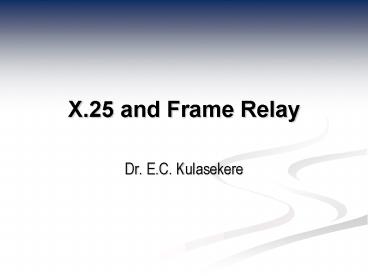X'25 and Frame Relay PowerPoint PPT Presentation
1 / 16
Title: X'25 and Frame Relay
1
X.25 and Frame Relay
- Dr. E.C. Kulasekere
2
Section Objectives
- The need for X.25 Protocol as the interface
between an end system and a packet switching
network. - Frame relay system
- Frame relay as an improvement to X.25
3
What is X.25?
- In a packet switched network the data travels in
packets. Hence unlike a circuit switched network
certain cooperation is necessary between DTEs. - This cooperation strategy is embodied in the X.25
interface standard. - This is almost universally used to interface
packet switched networks.
4
X.25
- Interface between host and packet switched
network - Almost universal on packet switched networks and
packet switching in ISDN - Defines three layers
- Physical
- Link
- Packet
5
X.25
- Physical level
- This deals with the physical interface between
the attached station (computer, terminal).
Version of X.21 standard is used. - Link level
- The link level is responsible for reliable
transmission of information using the physical
link. - Packet level
- Establishment of the logic channel or virtual
circuit
6
X.25 use of Virtual Circuits
7
X.25 use of Virtual Circuits
- Virtual Call
- Dynamically established
- Permanent virtual circuit
- Fixed network assigned virtual circuit
- Not a one to one link as in circuit switching but
a virtual/logical link that can connect multiple
DTEs. - Example Station D keep tracks of thee message
streams depending on their virtual circuit umber.
8
X.25 Multiplexing
- DTE can establish 4095 simultaneous virtual
circuits with other DTEs over a single DTC-DCE
link - Packets contain 12 bit virtual circuit number
9
X.25 Flow and Error Control
- Each packet is uniquely numbered so duplicates
can be discarded - Nodes can remember packets already forwarded to
keep network load in bounds - Can include a hop count in packets
- X.25 involve extensive flow control and error
control (hop-to-hop)
10
X.25 Characteristics
- Call control packets, in band signaling
- Multiplexing of virtual circuits at layer 3
- Layer 2 and 3 include flow and error control
- Considerable overhead
- Not appropriate for modern digital systems with
high reliability. Since with the new technology
the overheads used for X.25 cannot be justified.
11
Frame Relay
- Designed to to provide a more efficient
transmission scheme than X.25 - Frame relay is a precursor to ATM
- Purely connectionless approach
12
Frame Relay Characteristics
- Call control carried in separate logical
connection - Multiplexing and switching at layer 2
- Eliminates one layer of processing
- No hop by hop error or flow control
- End to end flow and error control (if used) are
done by higher layer - Single user data frame sent from source to
destination and ACK (from higher layer) sent back
13
FR Advantages and Disadvantages
- Lost link by link error and flow control
- Increased reliability makes this less of a
problem - Streamlined communications process
- Lower delay
- Higher throughput
- ITU-T recommend frame relay above 2Mbps
14
How does Frame relay differ from X.25?
- Frame relay is much simplified, compared to X.25.
- Frame relay uses out-of-channel signaling while
X.25 uses all in-channel control. - In frame relay there is no "hop-by-hop" flow
control or error control as there is in X.25. If
a frame error is detected it is just dropped
rather than being retransmitted.
15
How does Frame relay differ from X.25?
- Similarly, in frame relay, on an end-to-end
basis, there is no error control or flow control
except what is provided by higher level protocols
outside of frame relay. - Frame relay is a two level (physical and link)
layer protocol and the multiplexing of logical
channels takes place at Level 2 rather than in
the Level 3 Packet Layer as in X.25.
16
Problems.
- What are the relative advantages and
disadvantages of frame relay compared to X.25? - Because frame relay is so much simpler than X.25,
the processing to support switching can be
reduced and higher data rates than for X.25, up
to several megabits per second, can be supported.
On the other hand, because of the lack of
hop-by-hop flow control, the user of frame relay
has fewer tools to manage network congestion.
The effective use of frame relay also depends on
the channels being relatively error free. For
example, this is true for fiber optics, but
probably not for most forms of broadcast,
wireless transmission.

